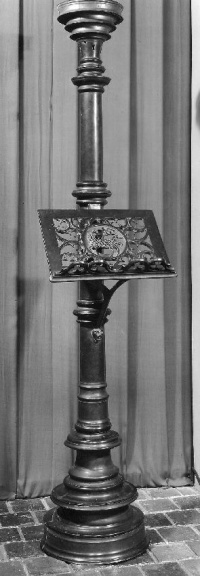Difference between revisions of "Chandelier-lutrin"
| Line 50: | Line 50: | ||
|candelabro con atril | |candelabro con atril | ||
|- | |- | ||
| − | |||
| − | |||
| − | |||
| − | |||
| − | |||
| − | |||
| − | |||
| − | |||
| − | |||
| − | |||
|} | |} | ||
| Line 72: | Line 62: | ||
* [[Chandelier-lutrin de Rochefort]] | * [[Chandelier-lutrin de Rochefort]] | ||
* [[Chandelier-lutrin de Saint-Ghislain]] | * [[Chandelier-lutrin de Saint-Ghislain]] | ||
| − | |||
| − | |||
| − | |||
Revision as of 17:44, 29 November 2021
Contents
Étymologie
Chandelier : < latin candela, « chandelle ».
Lutrin : < bas-latin lectrinum, de lectrum, pupitre chez Isidore de Séville (Carthagène, entre 560 et 570 - Séville, 636, évêque de Séville (cfr Littré). Mais lectrum est en fait utilisé dans les Glossae Isidori, attribuées à Isidore de Séville, cfr Du Cange : LECTRUM. Glossæ Isid : Lectrum, analogium super quo legitur. Eædem Glossæ : Pulpitum, analogium, Lectrum. (Notice Lectrum, dans du Cange, et al., Glossarium mediae et infimae latinitatis, 1678, éd. augm., Niort : L. Favre, 1883‑1887, t. 5, col. 054a).
Définition
Grand chandelier, souvent en métal, pourvu d'un lutrin. Il s'agit souvent d'un chandelier pascal.
Hiérarchie
Origines et développements
xxx
Typologie
xxx
Textes normatifs
xxx
Synode XXX :
Autres dénominations
| Autres langues | |
|---|---|
| NL | kandelaar-lessenaar |
| EN | candelabrum with a lectern |
| DE | Leuchter mit Chorpult |
| IT | leggio con portacandele |
| ES | candelabro con atril |
BALaT
Les chandeliers-lutrins (1400-1700) dans BALaT - Photothèque
Représentations de chandeliers-lutrins (1400-1700) dans BALaT - Photothèque
Les chandeliers-lutrins dans BALaT - Bibliothèque
